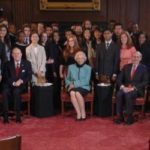Do your students know what they’re free to say online? At school? On a public street corner? From censorship to cyberbullying, the First Amendment and the freedoms it protects are as hotly contested as ever. This EDCollection explores 16 free speech debates ranging from the founding of our nation to recent headlines to illustrate what free speech actually means, where it comes from, and how far it can go. Whether you’re a social studies teacher looking for a complete unit or an English teacher looking to spend a single class period on free expression, there’s something for everyone. Free registration required.
Freedom of Speech
In this lesson, students examine the historical context and the drafting of the First Amendment by examining the motivations of the founding generation. Students will also examine various types of “speech,” such as symbolic speech, hate speech, and political speech, to address the scope of protections promised by the First Amendment and learn that speech can only be limited when it is intended to and likely to cause imminent violence. In each instance, students will explore when the government has some authority to restrict speech; areas of consensus among scholars, judges, and citizens; the strongest constitutional arguments on each side of contested issues; and U.S. Supreme Court cases that have addressed free speech rights.
First Amendment: Speech
When does the First Amendment allow the government to limit speech? Many Americans struggle with understanding the language and subsequent interpretation of the Constitution, especially when it comes to the rights encapsulated in the First Amendment. While many Americans can agree that speech should be protected, there are disagreements over when, where, and how speech should be limited or restricted. This lesson encourages students to examine their own assumptions and to deepen their understanding of current accepted interpretation of speech rights under the First Amendment, including when and where speech is protected and/or limited. It should reinforce the robustness of the First Amendment protections of speech.
Freedom of the Press
Students explore the scope and limitations of the First Amendment provision that protects freedom of the press. The lesson poses a hypothetical scenario involving student journalists handling private information. After a brief class discussion, students investigate the history, various interpretations, and modern relevance of First Amendment freedom of the press protections in the Interactive Constitution. The lesson builds on the freedom of speech lesson plan by asking students to compare and contrast the freedoms of speech and press through discussion questions including: How are speech and press related? and How are speech and press key to democratic functions?
IRL 1: Free Speech in Schools Podcast
We’re digging into four incredibly important Supreme Court cases – four cases that have shaped how we interpret the meaning of free speech in public schools. Is political protest allowed in class? Is lewd speech covered by the First Amendment? Can school administrators determine what students can and can’t say in the school newspaper? Listen in, and find out how students and schools have gone head to head over how First Amendment rights apply in a public school setting.
The Campus Speaker: A Case Study in Free Speech
Use this classroom-ready lesson to examine free-expression issues surrounding a controversial speaker invited to appear at UC Berkeley. We provide questions to help guide your students on if and when offensive speech should be banned, and what are the competing groups and interests.
A Conversation on Freedom of Speech

Justices Stephen G. Breyer, Anthony M. Kennedy and Sandra Day O’Connor and students discuss the First Amendment’s right to free speech, and in particular students’ free speech rights in the Supreme Court cases Tinker v. Des Moines Independent Community School District and Morse v. Frederick. In the Tinker case, students wore black armbands to school in silent protest of the Vietnam War. In the Morse case, a student held up a sign that said “Bong HITS 4 Jesus” at a parade.
Freedom of Speech: Finding the Limits
As part of the Bill of Rights, freedom of speech is guaranteed by the Constitution, but it is not defined by it. That task is left up to the people through a representative government that makes the laws and a judicial system that interprets and applies the laws to resolve disputes. In this lesson, based on the Annenberg Classroom video “A Conversation on the Constitution: Freedom of Speech,” students gain insight into the many challenges involved in defining and protecting free speech. They also learn about principles that come from Supreme Court decisions and case law that are applied to define the limits for us today.
Freedom of Speech
In this lesson, students analyze a photo of Robert Kennedy speaking outside the U.S. Department of Justice on June 14, 1963, and use it to discuss freedom of speech as a constitutional right in the United States, and human rights around the world.
You Rule!
An activity where the class gets to vote on hypothetical speech cases in schools based on precedent from six real Supreme Court cases.